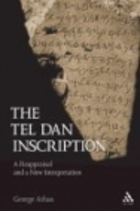
This post outlines the arguments of George Athas on the famous “House of David” lexeme that appears in the published version of his 1999 doctoral dissertation, The Tel Dan Inscription: A Reappraisal and a New Interpretation (2003).
Athas believes that the critical word often translated as House of David is in fact a geographical place-name and probably a reference to Jerusalem. I will cover Athas’s historical commentary in which he discusses the relevance of the expression as evidence for a historical Davidic dynasty in a future post. I have not covered every detail of Athas’ comments, omitting some subordinate arguments such as a proposed translation that introduces a cookhouse into the inscription, or where an argument against a particular amended text in Amos 8:14 is rejected because it breaks the parallelism in the verse. On the other hand, I have expanded some details, such as journal names and biblical quotations. Do let me know if you notice any errors in the Hebrew/Aramaic letters. The Tel Dan is an Aramaic inscription.
To begin with, here is a translation by George Athas of fragment A in which the apparent “House of David” appears, along with line numbering:
| A1 | [. . . .]you will rule ov[er | ] |
| A2 | [and because of the p]iou[s acts] of my father, may [?] go up [ | ] |
| A3 | and my father will repose. May he go to [ | at every] |
| A4 | ancient [h]earth on the ground of El-Bay[tel | am] |
| A5 | I, so Hadad would go before me [ | the day-] |
| A6 | -s of my reign, and I would slay a kin[g] and [ | thousands of cha-] |
| A7 | -riots and thousands of horsemen [ | ] |
| A8 | the king of Israel, and [I] killed [him | kin-] |
| A9 | -g of Bayt-Dawid. And [the] name [of | ] |
| A10 | their land to [ | ] |
| A11 | another and to [ | Jehoash r-] |
| A12 | -eigned over Is[rael | I laid] |
| A13 | siege to [Samaria | ] |
There are two fragments, A and B. Athas discusses the evidence for placing the B fragment below fragment A (e.g. the evidence that the scribe did not have to stretch when engraving B as he did with the letters in A, and the breakdown of the text’s alignment if B is placed alongside A). This changes how scholars interpret the possible overall message on the monument, but does not affect the meaning of the apparent “House of David” reference.
ביתדוד – the controversy
Biran and Naveh first proposed the theory that this should be interpreted as “House of David” – that is, referring to the “dynastic name of the kingdom of Judah”. (‘An Aramaic Stele Fragment from Tel Dan’, Israel Exploration Journal 43 (1993), pp. 81-98. Continue reading “The Tel Dan inscription: the meaning of ביתדוד, “House of David””
